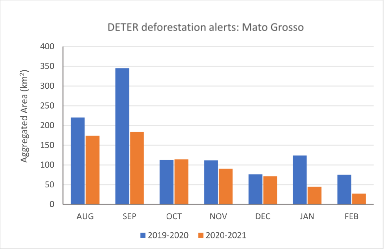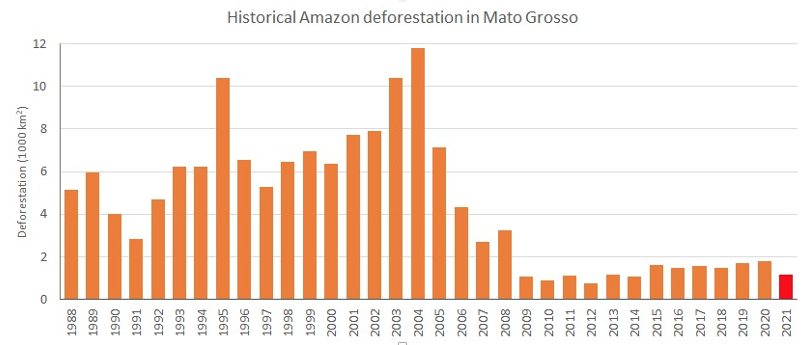Amazon Deforestation Declines by One Third in Mato Grosso State
New figures from the Brazilian state of Mato Grosso point to a sharp decline in Amazon deforestation over the past 6 months compared to the same period a year ago. The reduction follows a similar trend across Brazil’s Amazon basin and is a welcome turn following several years of rising rates of forest loss.
One year ago Mato Grosso launched a multi-agency, statewide strategy to reduce illegal deforestation, illegal logging and forest fires with partial funding from Germany and the UK through a “results-based” climate finance contract.
“Many people tend to overlook the critical role of the state governments of the Amazon in controlling illegal deforestation and logging,” said EII Executive Director Daniel Nepstad. “From the evidence I've seen, Governor Mauro Mendes and (Mato Grosso) Secretary of Environment Mauren Lazzaretti deserve a lot of credit for this important progress.”
EII is currently providing technical support to the government of Mato Grosso on a range of climate and conservation-related issues, including full implementation of the state's jurisdictional REDD+ program, development of a “climate neutral soy” product, and increasing the efficiency of its environmental licensing process.
Official data from the Deforestation Detection System in Real Time (DETER), part of Brazil’s national space research institute INPE, shows a 33.8% dip in deforestation alerts between August 2020 and February of this year when compared to the same period from 2019-2020. Approximately 705 km2 of forest fell in the state compared to 1065 km² the previous year.
Across the Amazon cumulative deforestation rates have fallen approximately 21%.

Unlike Brazil’s PRODES system, which provides aggregate annual reports on deforestation totals, DETER provides frequent deforestation alerts to alert authorities. DETER data also helps identify possible deforestation trends. The latest figures suggest that after several years of rising deforestation, rates now appear to be falling.
Lazzaretti, who took office in January 2019, credits that progress to her agency’s zero-tolerance approach to illegal deforestation and strategic investments in preventing and combating illegal forest clearing and fires.
"The seizure of equipment used in deforestation, the embargo of targeted areas and the application of fines,” helped to “de-capitalize” illegal actors, she told reporters. Indeed, 157 tractors, 11 trucks and a helicopter were seized in 2020, along with 492 people who were arrested for illegal activities.
Part of Mato Grosso’s approach includes the creation of the State Committee for Combatting Illegal Deforestation, Illegal Logging, and Forest Fire (CEDIF-MT) in March of 2020. The committee brings together official agencies including civil and military police,fire brigades and the Environment and Security secretariats. Drawing on alerts from high resolution planet data, the state is able to more effectively plan and mobilize resources to protect forests.
Funding for the stepped-up enforcement was made available via Germany’s REDD for Early Movers (REM) Program, which rewards tropical forest states for past progress on reducing deforestation in their territories, a key piece in the broader goal of preventing global warming from surpassing the 2° limit set under the Paris Climate accord. REDD stands for Reduced Emissions from Deforestation and Forest Degradation and is a UN program that seeks to mitigate climate change through enhanced forest management.
Mato Grosso saw dramatic success in reducing deforestation in years past with an 88% decline between 2005 and 2012 (rates have climbed since then, with 2020 marking the highest rate on record this decade). International recognition and reward for this achievement was delayed, however, until the German and UK contract, signed in 2017 with funds being disbursed in subsequent years.

Mato Grosso and the Brazilian State of Acre are the only subnational (state or province) jurisdictions to have received REM payments. In Mato Grosso, part of those funds—approximately R$8 million—went toward the purchase of satellite imaging and computing technology now used by CEDIF-MT.
Monica De Los Rios directs EII’s programs in Brazil. She said REM payments have been “critical for Acre and Mato Grosso to continue with forest monitoring and enforcement activities” at a time when other state governments are diverting funds intended for environmental protections in the wake of the COVID 19 pandemic.
Lazzaretti notes the renewed enforcement allows the government to more easily distinguish those who are operating within the law versus those who are violating legal restrictions on forest clearing, addressing a key concern among law-abiding farmers in the state who have long complained of being tarnished by the activities of a small minority.
Mato Grosso is Brazil’s leading agricultural producer and a major actor on the global commodities market, topping the list in exports of soy, corn and other staples. The rapid expansion in production over the past decade helped spur an economic boom but also raised alarm bells over the fate of Amazon forests and the adjacent Cerrado woodland savannah, home to 60% of soy production in Brazil.
EII Senior Policy Analyst João Shimada, who is based in Mato Grosso’s capital, Cuiaba, says he was surprised by the decline in forest loss. Like Lazzaretti, he credits a “massive zero tolerance campaign,” including TV spots like this one, and a new system put in place by the current government that lowers the credit rating of those involved in illegal activities, potentially prohibiting them from accessing loans and other forms of financing.
“It’s difficult to say with absolute certainty at this stage,” explained Shimada, “but the larger reductions in Mato Grosso [as compared to the rest of the Amazon] are likely thanks to the steps now being taken by the state government.”
